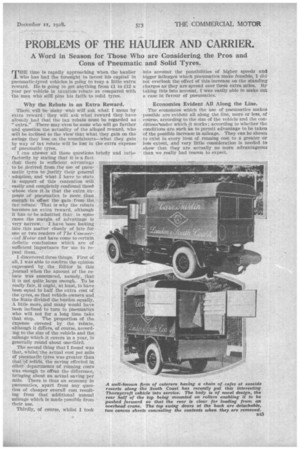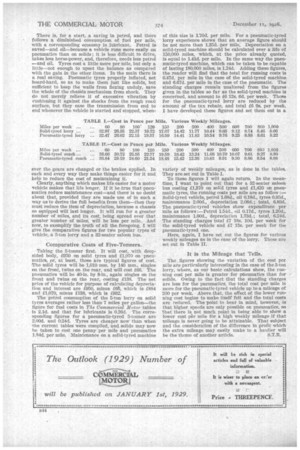PROBLEMS OF THE HAULIER AND CARRIER.
Page 27

Page 28

If you've noticed an error in this article please click here to report it so we can fix it.
A Word in Season for Those Who are Considering the Pros and Cons of Pneumatic and Solid Tyres.
MHE time is rapidly approaching when the haulier 1 who has had the foresight to invest his capital in pneumatic-tyreel vehicles is going to reap a little extra reward. Ile is going to get anything from LI to £12 a year per vehicle in taxation• rebate as compared with the man who still pins his faithto solid tyres.
Why the Rebate is an Extra Reward.
There. will be Many 'whb will ask what I mean by extra reward ; they will ask what reward they have
already had that the tax rebate must be regarded as "extra." _There may even be some who will go farther and question the actuality of the alleged reward, who
will be inclinedto the view that What they gain on the swings they lose on the roundabouts—what they gain by way of tax rebate will be lost in the extra expense of pneumatic tyres. can answer all these questions briefly and satisfactorily by stating that it is a fact that there is sufficient advantage to be slerived from the use of pneumatic tyres to justify their general adOption, and what I have .to state in support of this contention will easily and completely confound thos6 whose view it is that the extra...expep.Se of pneumatics is more than enough tro .offset the gain from the tax rebate; That is why the rebate becomes an extra reward, although it has td. be Admitted that in Some cases_ the margin of advantage is very narrow.. have. been. looking into this matter closely of late for one or two readers of The Commercial Motor and have come to certain definite conclusions which are of sufficient importance for me to repeat them..
I discovered three things. First of all, I was able to confirm the opinion expressed by the. Editor hi this journal when the amount of the rebate was announced, namely, that it is not quite large enough. To be really fair, it ought, at least, to have been equal to half the extra cost of the tyres, so that vehicle owners and the State divided the burden equally. A little more, and many would have been inclined to turn to pneumatics who will not for a long time take that step. The proportion of the expense covered by the rebate, although it differs, of course, according to the size of the vehicle and the • mileage which it covers in a year, is generally round about one-third.
The second thing that I found was that, whilst tlie actual cost per mile Of pneumatic tyres was greater than that 49f Solids, the saving effected in Other departments of running costs Was enough to offset the difference, bringing about an actual saving per mile. There is thus an economy in pneumatics, apart from any question of cheaper overall cost resulting from that additional annual mileage which is made possible from their use.
Thirdly, of course, whilst I took into account the possibilitiei; of higher speeds and bigger Mileages which pneumatics make feasible, I did, not overlook the effect Of this increase on the standing charges as they are spread over thee extra miles. 13y• taking this into account, I Was easily able to make out a case in favour of pneumatics.
Economies Evident All Along the Line.
The economies which the use of pneumatics makespossible are evident all along the line, more or less, of course, according to the size of the vehicle and the conditions4under which It works ; according to whether the conditions are such-as to permit advantage to be taken of the possible increase in mileage. They can be shown to exist in every item of running cost to a greater or leSs extent, and very little consideration is needed to show that they are actually no more advantageous than we really had reason to expect.
There is, for a start, a saving in petrol, and there follows a diminished consumption of fuel per mile, with a corresponding economy in lubricant. Petrol is saved-and oil-because a vehicle runs more easily on pneumatics than on solids ; it is leas difficult to drive, takes less horse-power, and, therefore, needs less petrol -and oil. Tyres cost a little more per mile, but only a little-not enough to upset the balance as compared urith the gain in the other items. In the main there is a real saving. Pneumatic tyres properly inflated, not board-hard, so as to make them just like solids, but sufficient to keep the walls from flexing unduly, save the whole of the chagsis mechanism from shock. They do not merely relieve it of excessive vibration by cushioning it against the shocks from the rough road surface, but they ease the transmission from end to end whenever the vehicle is started and stopped, when ever the gears are changed or the brakes applied. In each and every way they make things easier for it and help to reduce the cost of maintaining it.
Clearly, anything which makes life easier for a motor vehicle makes that life longer, If it be true that pneumatics reduce maintenance cost-and there is no doubt about that, provided they are made use of in such a way as to derive the full benefita from them-then they must reduce the item of depreciation, because a chassis so equipped will last longer. It will run for a greater number of miles, and its cost, being spread over that greater number of miles, will be less per mile, And now, to exemplify the truth of all the foregoing, I will give the comparative figures for two popular types of vehicle, a 5-ton lorry and a 32-seater saloon bus.
Comparative Costs of Five-Tonners.
Taking the 5-tanner first. It will cost, with deepsided body, £950 on solid tyres and 11,070 on pneumatics, pr, at least, those are typical figures of cost. The solid tyres will be 1,010 mm. by 140 mm., singleson the front, twins on the rear, and will cost £66. The pneumatics will be 40-in. by 8-in., again singles on the front and twins on the rear, costing £138. The net price of the vehicle for purpose of calculating depreciation and interest are £950, minus 164, which is 1884 and £1,070, minus £138, which is 1.932.
The petrol consumption of the 5-ton lorry on solid tyres averages rather less than 7 miles per gallon-the figure for fuel costs in The Commercial Motor tables Is 2.1d. and that for lubricants is 0.26d. The corresponding figures for a pneumatic-tyred 5-tanner are 2.00d. and 0.24d. Tyres are cheaper now than when the current tables were compiled, and solids may now be taken to cost one penny per mile and pneumatics 1.84d. per mile. Maintenance on a solid-tyred machine of this size is 1:70d. per mile. For a pneumatic-tyred lorry experience shows that an average figure should be not more than 1.35d. per mile, Depreciation on a solid-tyred machine should be calculated over a life of 150,000 miles, which, at the price already quoted, is equal to 1.41d. per mile. In the same way the pneumatie-tyred machine, which can be taken to be capable of lasting 180,000 miles, is 1.24d. Adding these figures, the reader will find that the total for running costs is 6.47th per mile in the case of the solid-tyred machine and 6.67d. per mile in the case of the pneumatic. The standing charges remain unaltered from the figures given in the tables so far as the solid-tyred machine is concerned, and amount to £6 12s. 6th per week. Those for the pneumatic-tyred lorry are reduced by the amount of the tax rebate, and total £6 9s. per week. I have developed these figures and set them out in a variety of weekly mileages, as is done in the tables. They are set out in Table I.
To these figures I will again return. In the meantime, I want to point out that for a 32-seater saloon bus costing £1,370 on solid tyres and £1,420 on pneumatic tyres, the running costs per mile are as follow :Solid-tyred vehicle, petrol 1.68d., oil 0,18d., tyres 0.95d., maintenance 2.00d., depreciation 2.08d.; total, 6.89d. The pneumatic-tyred vehicles show expenditure per mile as follows ;-Petrol 1.54d., oil 0.17d., tyres 1.20d., maintenance 1.60d., depreciation 1.73d.; total, 6.24d. The standing charges total £7 18s. 10th per week for the said-tyred vehicle and £7 13s. per week for the pneumatic-tyred one.
Here, again, I have set out the figures for various weekly mileages as in the case of the lorry. These are set ont in Table IL
It is the Mileage that Tells.
The figures showing the variation of the cost per mile are particularly interesting in the case of the 5-ton lorry, where, as our basic calculations show, the TIM
• Ding cost per mile is greater for pneumatics than for solids. Owing to the fact that the standing charges are less for the pneumatics. the total cost per mile is more for the pneumatic-tyred vehicle up to a mileage of 200 per week. Above that, the effect of the lower running cost begins to make itself felt and the total costs are reduced. The point to bear in mind, however, is that higher spe?.cls are only possible on pneumatics, so that there is not much point in being able to show a lower cost per mile for a high weekly mileage if that mileage is never going to be attainable. That subject and the consideration of the difference in profit which the extra mileage may easily make to a haulier will be the theme of another article. S.T.R.






























